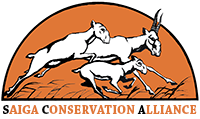*Saiga horns are also known as ling yang (羚羊) and used in Traditional Chinese Medicine
Period: January 1st 2007- December 31st 2009
Participants
Fauna and Flora International
Elena Bykova, Institute of Zoology, Academy of Sciences of Republic of Uzbekistan
Alexander Esipov, Institute of Zoology, Academy of Sciences of Republic of Uzbekistan
Dmitry Golovtsov, Chatkal Biosphere nature reserve
Background
Saiga numbers on the Ustyurt plateau have declined dramatically in the decades following the collapse of the Soviet Union and immediate conservation action is required to prevent the extinction of this species locally. The main driver in the decline is poaching and rural poverty, pressures that can be addressed through public awareness and targeted empowerment. There is a proclaimed protected area for saiga in this region of Uzbekistan, but no enforcement. A small amount of investment into local engagement and saiga publicity has the potential to return significant conservation gains.
Main saiga population in Uzbekistan concentrates in the period of winter migration. This species also lambed in the northern part of Karakalpak Ustyurt. Hunting primarily focuses on horned males that sharply reduced reproductive potential of the population, including reduced fertility and greater mortality of newborns. All this has become a result of consistently high poaching rates and fragmentation and degradation of the Ustyurt natural habitats.
The human population of Ustyurt plateau is low. Most people live in the vicinity of railway stations (Kungrad-Beyneu) or gas compressing stations along the pipelines (Bukhara-Ural). Shepherds live in small, widely distributed farms in spring and early summer.
Historically the Uzbek part of Ustyurt plateau has been inhabited by nomadic families (ulus) of Kazakhs. A settled population has appeared here relative recently (about 30 years ago). People arrived from different parts of former Soviet Union for the building and servicing of the Kungrad-Beneu railway and 2 gas pipelines. Our previous investigation shown the educational level of people is rather high; they are well informed about saiga biology and correctly understand the reasons for its decline. However, most of people know nothing about nature conservation and sustainable of use of wildlife resources.
Our previous project supported by FFI (Socio-economic survey of main reasons of the saiga declining in Uzbekistan) identified Jaslyk and Karakalpakia villages as key locations for saiga conservation. Both villages are known to be the main base for professional saiga hunters in the region. It’s why we concentrated our efforts for work with people from these settlements involving there in saiga conservation process through participation in scientific based monitoring of saiga population.
Goal
To establish local ranger groups to monitor saiga populations in their area, and act as advocates for saiga conservation. The associations, based on the hunting association model, would be officially recognised and formally constituted. Individuals who are known to be ex-poachers would be targeted to join these groups; their hunting expertise and contacts among poachers make them particularly suitable as monitors, tour guides and potential champions for saigas in their communities. The project would also include awareness-raising among local communities and collaborative action with the relevant Ministries.
Objectives
• To monitor the population of saiga on the Uzbekistan Ustyurt and to ascertain the scale and focus of saiga poaching
• Saiga conservation through the formation of rangers groups formed of ex-poachers.
• Raise public awareness and increased support from local communities for the plight of the saiga antelope.
• Develop a better understanding of public perception regarding saiga poaching.
• Develop capacity of rangers to undertake saiga monitoring.
Early Results
During 2007 we have collected and analyzed data on the saiga ecology including time of saigas staying in territory of Uzbekistan during migration and rut (winter migration from northern areas of Kazakhstan and spring migration from Uzbekistan to Kazakhstan) as well as data on saiga birth and being in territory of Uzbekistan. For data collection we developed and produced in Russian and Kazakh (languages are good understandable by local people) monitoring questionnaire and carried out joint expedition.
Monitoring saigas with the participation of local people is rather new and highly effective way of engaging them in saiga conservation, as well as a potentially cost-effective method of obtaining robust data year-round, rather than only on our expeditions. Our focus group is hunters. As a rule this sort of the people is very secretive because they know well that their business is illegal. That is why we act very accurate to recruit new members of monitoring group. As a rule we ask people who know us well organize meetings with hunters. We explained that we need help each of them to understand current situation with saiga and development approaches for saiga conservation. On the one hand we attracted people for the scientific based investigation that surely raised their self-appraisal and allowed to develop new vision of common things. On the other hand we very softly and effective propagandized ideas of saiga conservation through work for saiga monitoring and day by day friendly conversation. Involvement people from two villages allow covering by observation most part of saiga range in Uzbekistan.
So, one year survey has shown that method of participatory monitoring works well. We collected annual data on saiga status in Uzbekistan. Local people have been involved in this process very close and received benefits (salary for observation and development of monitoring form). Also this method together with public awareness activities allows advocating saiga conservation in local community and stimulates a new vision.
